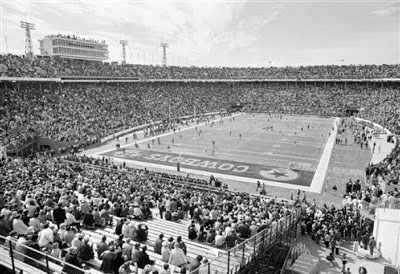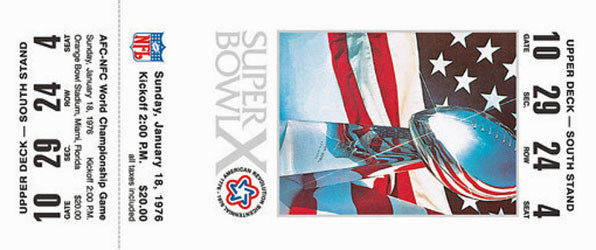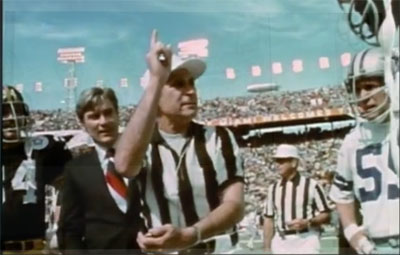Super Bowl X - Pittsburgh Steelers vs Dallas Cowboys: Pregame
 Lynn Swann
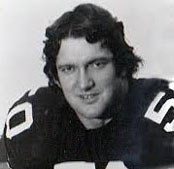
Jim Clack
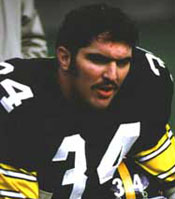
Andy Russell
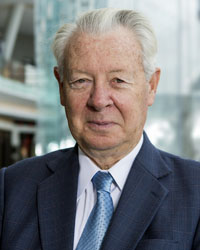
Tim Rooney in later years
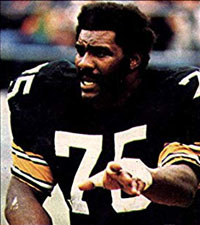
Joe Greene

Chuck Noll
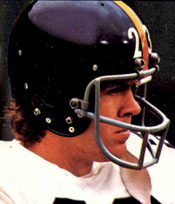
Mike Wagner

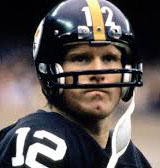
Terry Bradshaw
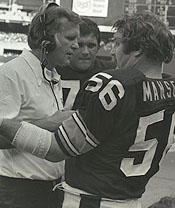
Dan Radakovich with
C Ray Mansfield

Myron Cope
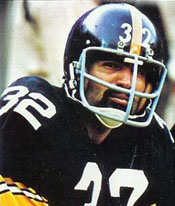
Franco Harris
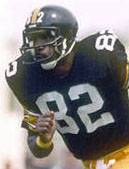
John Stallworth
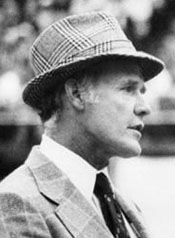
Tom Landry in his trademark fedora
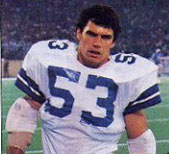
Bob Breunig
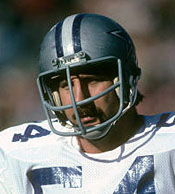
Randy White
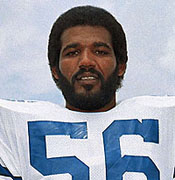
Hollywood Henderson

Preston Pearson
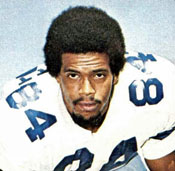
Jean Fugett

Robert Newhouse

Tex Schramm
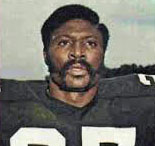
Glen Edwards
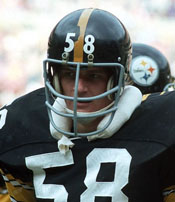
Jack Lambert
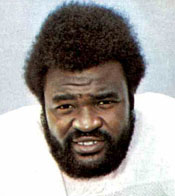
Rayfield Wright
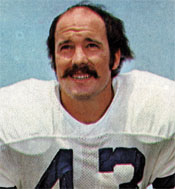
Cliff Harris
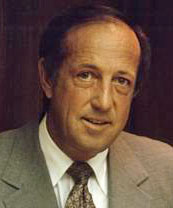
Pete Rozelle

Roy Gerela
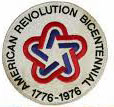
|
Fresh off the first championship in franchise history, Chuck Noll's Pittsburgh Steelers were overwhelming favorites to defend their AFC title.
- The only changes in the starting lineups were on offense:
--
Lynn Swann at WR in place of Ron Shanklin
-- Jim Clack at LG instead of Sam Davis
The Steel Curtain defense returned intact, all still in their 20s except their leader, RLB Andy Russell, age 34.
Noll was the perfect coach for a team coming off a championship because he never gave his players a feeling they had it made.
DB Mike Wagner: Quite honestly, that was intentional on Chuck's part. That's how he wanted to coach. You figured out as a player you had to earn your spot. Not only every year but every week. ... The key thing is, that was across the board, didn't matter who you were.
The Steeler head man also intimidated through silence. Wagner: Sometimes if people aren't talking a lot, you kind of are wary, particularly if they're in a position of power. And I think that was one of his tools.
DT Joe Greene recalled: The same things we were doing when we were 1-13 were the same things we were doing in 1975. But with much better players.
- The improved play of two men produced a much better offense in '75: Terry Bradshaw and Lynn Swann, as the numbers bear out. (Bold numbers indicate NFL leader.)
QB Terry Bradshaw
| Year |
Atts-Comp-% |
Yds |
TD |
Int |
| 1974 |
148-67-45.3 |
785 |
7 |
8 |
| 1975 |
286-165-57.7 |
2055 |
18 |
9 |
|
WR Lynn Swann
| Year |
Receptions |
Yds |
TD |
| 1974 |
11 |
208 |
2 |
| 1975 |
49 |
781 |
11 |
|
Bradshaw recalled in his first autobiography: As we started the 1975 season, all of us were pretty confident about our team overall. Noboby was comparing me with any of the fine QBs around, and I neither expected it nor deserved it. But I was at a place where I felt I could contribute something once in a while instead of being just a robot. ... But mainly I was learning not to run with the football.
Tim Rooney, Steelers' director of pro personnel, recalled: (1975) was where Bradshaw and the passing game started to really come into effect. That team was much better (than in 1974) because those kids on offense started to mature, and the defense was still extremely good.
This table shows the impact on the Pittsburgh offense.
Steelers Offense
| Year |
Rush Yds |
Pass Yds |
Pts |
Rank |
| 1974 |
2417 |
1958 |
305 |
7 |
| 1975 |
2633 |
2254 |
373 |
5 |
Improved offensive line play also contributed to the higher offensive ranking. The Big Uglies were benefitting from a second year under Dan Radakovich, an ardent film student. In addition to improving techniques, "Bad Rad" introduced several innovations that became standard throughout the league within a few years. He told the equipment manager to tailor the O-linemen's jersies to make them as tight as possible around the chest and biceps so that defensive linemen couldn't tug on them. He also made his linemen buy $100 padded gloves similar to those that boxers wore in training. The gloves protected linemen's hands when they popped them into the opponent's chest as quickly as possible after the snap.
If the Steelers were complacent, a 30-21 home loss to Buffalo in Week Two shocked them into reality.
Pittsburgh returned to top form in the playoffs.
- First, they belted Baltimore 28-10, outrushing the Colts 211-82.
This game is memorable for making the "Terrible Towels" a Steeler tradition. During one of sports broadcaster Myron Cope's 11 PM newscasts the week of the game, he urged fans to bring gold or black towels to the game. About half the crowd began waving them at the start of the playoff game. Over the decades, hundreds of thousands of the towels have been sold by the Steelers. Since 1996, the proceeds go to the Allegheny Valley School, which serves people with severe intellectual and developmental disabilities like Myron's son Danny, who became a resident in 1982.
- That brought the nasty Oakland Raiders to town for the teams' fourth straight playoff matchup. On a frigid day (windchill -12°) with ice in the corners of the field, the Steelers led 3-0 heading into Q4 before a 25y TD run by Franco Harris and a 20y scoring pass from Bradshaw to John Stallworth assured a 16-10 triumph.
DT Joe Greene, who missed five games with nerve damage in his right shoulde but made an inspiring return for the Raiders game, recalled after the Steelers won four Super Bowls in six years: Our best team ever was '75. They didn't even need me. The easiest of them all was that second time. We knew from day one where we were going.
Hardly anyone expected Dallas to make the NFC playoffs in what was considered a rebuilding year after a disappointing 8-6 1974 season that ended without a playoff berth for the first time since 1965.
- Four longtime stalwarts retired: DT Bob Lilly, S Cornell Green, FB Walt Garrison, and C Dave Manders. Furthermore, WR Bob Hayes was traded to the 49ers, and RB Calvin Hill signed with the Hawaiians of the World Football League.
- Twelve rookies adorned the Cowboys' roster, the biggest infusion of new talent into the team since the original expansion draft in 1960. Six became starters for Tom Landry, a coach who had never shown a preference for newcomers over veterans. The most productive of the "Dirty Dozen" were LBs Bob Breunig, Randy White, and Thomas "Hollywood" Henderson.
White: The Cowboys weren't picked to win the division and weren't picked to do much. We (the rookies) felt we brought some enthusiasm to some of the veterans that were there and we had some great veterans.
- Another addition was RB Preston Pearson, who had played in Super Bowl IX for the Steelers as well as Super Bowl III for the Colts. He helped offset the loss of Hill and Garrison.
The Steelers put Pearson on waivers a week before the season began because he had been one of the NFL Players Association members who organized a picket of the Pittsburgh practice facility during the previous summer's strike.
- Because their running attack was the weakest in over a decade, the '75 Cowboys became the first NFL team since the 1960 49ers to run almost all their offensive plays from the shotgun formation.
Staubach: Tom Landry and Mike Ditka ... told me, "Roger, we're going to experiment with a shotgun on third down." Hardly anyone had used it since the old single-wing days, but we could run draws and screens out of it, and it gave me more time to throw. I loved it! As the season progressed, the Cowboys used the spread formation on every down.
- Second-year WR Drew Pearson emerged as Roger Staubach's favorite target (46 receptions for 822y), followed by TE Jean Fugett (38/488) and Robert Newhouse and Preston Pearson out of the backfield.
- Coach Tom Landry praised his young team. Our rookies are the reason we're here in the Super Bowl. Our veterans said, "Our All-Pros are gone." But our guys said, "We're not through."
Years later, Landry still spoke highly of the '75 team: The veterans saw we had good rookies and played better, and that's the influence our rookies had on this club. That was the best group I had from the standpoint of character, morale, spirit, and teamwork. They were the type who gave you your greatest reward from coaching.
S Cliff Harris: It was one of my favorite years for the Cowboys. There was a time in the middle of the season where the press had given up on us and the fans had given up on us. We kind of internalized and motivated ourselves.
- Director of Player Personnel Tex Schramm admitted he was surprised by his club's performance. If you had told me we'd be here when I saw you last October, I'd have laughed in your face.
Staubach recalled: We really overachieved that year. Our running game was not what it usually was. We didn't know what to expect in '75 and the thing that really worked for us was that we still had good athletes. ... Coach Landry once said the '75 season was the best season we had.
Everything came together for Cowboys late in the season.
- They had to win their final two games to finish 10-4 and claim the NFC wild-card berth in the playoffs.
- One of the most memorable playoff games in NFL history took place in the first round when Staubach threw a desperation 50y TD pass to WR Drew Pearson with 24 seconds left to snatch a 17-14 victory away from the Minnesota Vikings.

Staubach throws and Drew Pearson catches the "Hail Mary." A devout Catholic, Roger was hit and knocked down right after throwing the pass. When asked if he saw the catch, he said he didn't. I just closed my eyes and said a Hail Mary. ... You throw it up and pray he catches it.
- Hitting the road again, the Cowboys blasted the Rams 37-7 to secure their third NFC championship in the last six years and become the first team to make the Super Bowl as a wild card. Dallas's "flex" defense held LA to just 22y rushing.
Numerous writers highlighted the contrast in styles between the two Super Bowl combatants. The differences have been described in various ways.
- If the Steelers were a stiff finger in your eye, the Cowboys were an unfelt hand lifting your wallet. To Pittsburgh, football was muscle and meanness; to Dallas, it was guile and trickery. (Phil Musick)
- The Steelers' version of football was modern, but not all that far removed the blood battles that had been taking place for the previous thirty years. See something, hit something - whether it was an opposing player or a hole in the offensive line. Noll used to preach not letting paralysis by analysis be your undoing. But the Cowboys were all about analysis. ... The saying was that Texas Stadium, home of the Cowboys, had a hole in the roof so God could watch his favorite team play. No one said that about Three Rivers, home of the Terrible Towel and ashen skies and sleet that stung the face like a hapin. No one dreamed of growing up to work in a steel mill; everyone dreamed of being a Cowboy. (Chad Millman and Shawn Coyne)
Noll recalled being more concerned about the Cowboys' "Flex" defense than their offense. The goal of the flex, which offset two linemen to combat counters and traps, was to contain every gap. I think defensively was where they were most complex, different than anybody else we played. We had to understand what they were doing. When we got into a formation, they had extensive scouting, and they would load up against you based on that information. We would study that and try to take advantage of that.
Comments from members of the two teams revealed the animosity each side felt for the other's approach.
The main question during the two weeks of preparation for the Super Bowl was whether Lynn Swann would play.
- During the playoff game with Oakland, DB George Atkinson delivered a blow to Swann's head after a completion, knocking Lynn out of the game with a concussion.
- Lynn spent two days in a Pittsburgh hospital, wondering if he would ever play football again. The rest of the week, he remained on the sidelines during practices except for some light running and a few pass patterns.
- The doctors cleared him to play but warned that another hit to the blow might cause permanent damage. They left the decision to take the field against Dallas to Swann. He told reporters he wouldn't risk his health for one game even if it was the Super Bowl.
A brain scan had been negative. Equilibrium and reflex tests came out okay. But post-concussion syndrome wasn't well understood in those days.
- Cowboys S Cliff "Captain Crash" Harris inadvertently made Swann's decision easier when he told the press: I'm not going to hurt anyone intentionally. But getting hit again while he's running a pass route must be in the back of Swann's mind. I know it would be in the back of my mind.
- But Cliff's comments backfired on him. His words made Swann's decision for him. I said to myself, "The hell with it. I'm gonna play." Lynn's statement to the press read: I'm still not 100 percent. I value my health, but I've had no dizzy spells. I read what Harris said. He was trying to intimidate me. He said I'd be afraid out there. He needn't worry. He doesn't know Lynn Swann. He can't scare me or the team.
Swann told Stallworth two days before the game: I'm worried about my timing. And my concentration isn't real good either.
- Two weeks not only provided more time for Swann to recover but also gave the Steelers time to prepare for the intricate Dallas offense with its myriad of formations and presnap shifts and motion as well as the Flex defense, which Pittsburgh had not seen during the regular season.
Noll: We talked a lot about ... how they had a great pass rush and then getting ready for them was not easy. They tried to fool you as much as beat you physically. We needed the two weeks to get ready and we used all of it.
Bleier: Our offensive plan was to recognize the flex defense, with the offset tackle. Most teams tried to run away from the flex, but we decided to attack it rather than be afraid of it.
Another theme as Super Bowl X approached was the lack of a really exciting game among the first nine.
- Still, the NFL issued a record number of press credentials: 1,735.
- Commissioner Pete Rozelle did his best to hype the game. The Super Bowl is like the last chapter of a hair-raising mystery. No one would think of missing it.
- When asked if he was concerned about the lack of excitement in the previous games, Pete replied: We've talked about it a lot, but it's something that's impossible to change as much as we'd like to. The game doesn't have electricity, I agree. The coaches go into it with conservative game styles. Certainly we'd like to see more exciting games like some of our playoffs.
- The Cowboys' game plan was calculated to produce excitement. Staubach recalled: Our game plan was simple. We were going to shoot the works. Instead of playing conservatively, we were going to take the chances necessary to make things happen.
- Staubach's opposite number, Bradshaw, said, It's gonna be a matter of whether we can run on the flex.
- Noll, never one to say too much, made what proved to be a prescient prediction. It might come down to big plays.
- Dallas assistant Ermal Allen also was right on target. If we want to win, we have to stop the bomb.
As in Super Bowl VIII in Houston, one team felt it got the short end of the stick in accomodations in Miami.
- The Steelers were "crabby and bored" at the "quaint but cramped" Miami Lakes Hotel. The excitement of their first Super Bowl the previous year was absent.
The weather was miserable all week - wind and rain, not what the Miami Chamber of Commerce ordered. The players felt cooped up and edgy.
- Let's get this over with and go home, said Ernie Holmes at his first press conference. I don't like this place. It's for people with arthritis. They come here to play golf or die. All that's out here are these mosquitoes and space. This is no place for champions.
Bradshaw: We're not as emotional as last year because we're better.
- Noll, on the other hand, acted as if he'd attended a charm school within the last year. However, he still spouted the usual platitudes. All teams who get to the Super Bowl are good on defense. In order to win, you first don't lose it.
- Meanwhile, the Cowboys enjoyed the glamorous beachfront Galt Ocean Mile Hotel in Fort Lauderdale - the same hotel where the Jets stayed before Super Bowl III.
- Jack Lambert pulled no punches. I hope Staubach is eaten by sharks.
Decades later, Staubach still laughed about that line. Lambert was a mean son of a gun. No front teeth, foaming at the mouth - he intimidated some of our players.
- Practices for both teams were more physical than usual.
Joe Gilliam, the Steelers' third QB who impersonated Staubach in the practices, said he hoped to live long enough for the real game to begin.
An unexpected problem for the NFL was the proliferation of fake tickets.
- With valid tickets costing $20 and being scalped for upwards of $200, the highest price in Super Bowl history, hucksters were offering counterfeit ducats for $30 or more.
- We could see right away they were counterfeit, said Jim Kensil, Rozelle's right-hand man. But it was an expensive counterfeit job. These have different row and seat numbers. Usually, the numbers are all the same because it's cheaper.
- One man bought 18 of the bogus tickets for $30 each. When the ink began the smudge, he contacted the police.
- The estimated take for the con men was $1.5 million.
The Steelers and Cowboys went through their usual routines the morning of the game.
- Pittsburgh enjoyed a breakfast of steak and eggs four hours before kickoff.
Steelers management allowed the wives to stay with their husbands the week of the game. But some players changed that setup Saturday night. Bleier: I didn't want to sleep with my wife the night before the game. So Jack Ham and I stayed together and our wives stayed together. And I was able to sleep.
- Swann headed to the Orange Bowl two hours before the rest of the squad. He set his leather tote bag on the floor, piled several towels atop it, and took a nap. When I woke up, I felt great, so ready to play, so ready to show the Cowboys and everyone else Lynn Swann can't be intimidated.
- Bleier: The locker room was pretty quiet before the game. We had an emotional group, but I guess we were refined in the sense that there wasn't a lot of yelling and screaming or slamming helmets. Because Chuck wasn't that kind of guy. He was not a rah-rah guy. Enthusiasm was another thing. He had that and his players had that.
Bleier: I was nervous. ... I got nervous before all games. Of course, this was the biggest game of the year, even though Chuck would say, "Put it in perspective: it is only one of 17 games." I had my little ritual in preparation, from coming in and getting dressed, to the number of sticks of gum that I'd be chewing, to my stretching inside the locker room, to going over all my plays from a mental-visualization aspect, to then going out for warmups. ... This game was more for ourselves than for Art Rooney and the fans of Pittsburgh, as had been Super Bowl IX.
- The Cowboys began the day with a Catholic mass in a hotel conference room and Protestant services in another. Trainers taped players in a third room before breakfast and departure for the stadium.
For the first time, wives of Dallas players were allowed to stay with their husbands over the weekend prior to the Super Bowl at the request of Coach Landry, who had allowed players to stay at home on Saturday nights before Sunday home games all season.
Pittsburgh was a 7-point favorite based on their defense that allowed only 12 points per game.
Steelers K Roy Gerela had missed two FGs and an extra point in the AFC Title Game against Oakland. He was destined for another bad day in the Super Bowl, starting with warmups.
- For some reason, the net behind the goalposts toward which he practiced was not raised. So all his kicks landed in the stands, where fans kept them.
- Frustrated that he was running out of balls to kick, Gerela went into the stands and grabbed a ball from a spectator.
Other fans, many dressed in Steeler grab, jostled him until security personnel escorted him back to the field.
- Out of practice balls, Roy and C Ray Mansfield sneaked over to the Cowboys' bench and stole some footballs.
- Swann dropped the first pass Bradshaw threw to him during pregame warmups but caught all the rest.
Bambi Brown, an exotic dancer from Atlanta wearing a cowboy hat with a D on it, ran onto the field to give T Rayfield Wright a silver chain with a horseshoe on it. This will give you good luck, she said. But he threw it down. I do't believe in things like that. I'm not superstitious. Things that happen are going to happen.
CBS telecast the game with Pat Summerall doing play-by-play and Tom Brookshier providing color. Kansas City coach Hank Stram joined them for Q4.
The pregame show featured the singing group Up with People, which represented an organization whose mission was to inspire young people to make a difference in their world.
- The theme of the pregame and halftime entertainment was "200 Years and Just a Baby: A Tribute to America's Bicentennial."
- Thousands of red, white, and blue balloons flew into the air toward the Goodyear Blimp.
- Both teams took the field on the slippery new Polyturf wearing red, white, and blue patches on their uniforms.
At kickoff, the skies were clear, but the temperature ws a chilly 56° with a gusting north wind as 80,197 gathered to watch one of the most thrilling of all Super Bowls.
Paramount Pictures contracted with the NFL to use the big game to film scenes for the movie Black Sunday about a terrorist plot to blow up a blimp over the Super Bowl.
|
| # |
Player |
Pos. |
Hgt. |
Wgt. |
College |
Exp. |
| 5 |
Terry Hanratty |
QB |
6-1 |
210 |
Notre Dame |
7 |
| 10 |
Roy Gerela |
K |
5-10 |
185 |
New Mexico State |
7 |
| 12 |
Terry Bradshaw |
QB |
6-3 |
215 |
Louisiana Tech |
6 |
| 17 |
Joe Gilliam |
QB |
6-2 |
185 |
Tennessee State |
4 |
| 20 |
Rocky Bleier |
RB |
5-11 |
210 |
Notre Dame |
8 |
| 23 |
Mike Wagner |
S |
6-1 |
210 |
Western Illinois |
5 |
| 24 |
J. T. Thomas |
CB |
6-2 |
195 |
Florida State |
3 |
| 27 |
Glen Edwards |
S |
6-0 |
185 |
Florida A&M |
5 |
| 31 |
Donnie Shell |
S |
5-11 |
190 |
South Carolina State |
2 |
| 32 |
Franco Harris |
RB |
6-2 |
230 |
Penn State |
4 |
| 33 |
Frenchy Fuqua |
RB |
5-11 |
205 |
Morgan State |
7 |
| 34 |
Andy Russell |
LB |
6-2 |
225 |
Missouri |
13 |
| 36 |
Dave Brown |
S |
6-1 |
190 |
Michigan |
1 |
| 38 |
Ed Bradley |
MLB |
6-2 |
240 |
Wake Forest |
4 |
| 39 |
Bobby Walden |
P |
6-0 |
190 |
Georgia |
12 |
| 43 |
Frank Lewis |
WR |
6-1 |
195 |
Grambling State |
5 |
| 44 |
Mike Collier |
RB |
5-11 |
200 |
Morgan State |
1 |
| 45 |
Jim Allen |
CB |
6-2 |
195 |
Pierce College, UCLA |
2 |
| 46 |
Reggie Harrison |
RB |
5-11 |
220 |
Cincinnati |
2 |
| 47 |
Mel Blount |
CB |
6-3 |
205 |
Southern |
6 |
| 50 |
Jim Clack |
G |
6-3 |
250 |
Wake Forest |
5 |
| 51 |
Loren Toews |
LB |
6-3 |
220 |
California |
3 |
| 52 |
Mike Webster |
C |
6-1 |
255 |
Wisconsin |
2 |
| 54 |
Marv Kellum |
LB |
6-2 |
225 |
Wichita State |
2 |
| 55 |
Jon Kolb |
T |
6-2 |
260 |
Oklahoma State |
7 |
| 56 |
Ray Mansfield |
C |
6-3 |
250 |
Washington |
13 |
| 57 |
Sam Davis |
G |
6-1 |
255 |
Allen |
9 |
| 58 |
Jack Lambert |
LB |
6-4 |
220 |
Kent State |
2 |
| 59 |
Jack Ham |
LB |
6-1 |
225 |
Penn State |
5 |
| 63 |
Ernie Holmes |
DT |
6-3 |
260 |
Texas Southern |
4 |
| 64 |
Steve Furness |
DT |
6-4 |
255 |
Rhode Island |
4 |
| 68 |
L.C. Greenwood |
DE |
6-6 |
245 |
Arkansas-Pine Bluff |
7 |
| 71 |
Gordon Gravelle |
T |
6-5 |
250 |
Brigham Young |
4 |
| 72 |
Gerry Mullins |
G |
6-3 |
245 |
USC |
5 |
| 74 |
Dave Reavis |
T |
6-5 |
255 |
Arkansas |
2 |
| 75 |
Joe Greene |
DT |
6-4 |
275 |
North Texas |
7 |
| 76 |
Jon Banaszak |
DT |
6-3 |
240 |
Eastern Michigan |
1 |
| 78 |
Dwight White |
DE |
6-4 |
255 |
Texas A&M-Commerce |
5 |
| 82 |
John Stallworth |
WR |
6-2 |
190 |
Alabama A&M |
2 |
| 84 |
Randy Grossman |
TE |
6-1 |
220 |
Temple |
2 |
| 86 |
Reggie Garrett |
WR |
6-1 |
170 |
New Mexico Highlands |
2 |
| 87 |
Larry Brown |
TE |
6-4 |
245 |
Kansas |
5 |
| 88 |
Lynn Swann |
WR |
5-11 |
180 |
USC |
2 |
|
1975 Dallas Cowboys
| # |
Player |
Pos. |
Hgt. |
Wgt. |
College |
Exp. |
| 9 |
Mitch Hoopes |
P |
6-1 |
205 |
Arizona |
1 |
| 12 |
Roger Staubach |
QB |
6-3 |
195 |
Navy |
7 |
| 15 |
Toni Fritsch |
K |
5-7 |
190 |
None |
5 |
| 19 |
Clint Longley |
QB |
6-1 |
195 |
Abilene Christian |
2 |
| 20 |
Mel Renfro |
CB |
6-0 |
190 |
Oregon |
12 |
| 21 |
Doug Dennison |
RB |
6-1 |
200 |
Kutztown (PA) |
2 |
| 26 |
Preston Pearson |
RB |
6-1 |
205 |
Ilinois |
9 |
| 30 |
Charley Young |
RB |
6-1 |
215 |
North Carolina State |
2 |
| 31 |
Benny Barnes |
CB |
6-1 |
190 |
Stanford |
4 |
| 41 |
Charlie Waters |
S |
6-1 |
195 |
Clemson |
6 |
| 42 |
Randy Hughes |
S |
6-4 |
210 |
Oklahoma |
1 |
| 43 |
Cliff Harris |
S |
6-1 |
190 |
Ouachita Baptist |
6 |
| 44 |
Robert Newhouse |
FB |
5-10 |
200 |
Houston |
4 |
| 45 |
Rolly Woolsey |
CB |
6-1 |
180 |
Boise State |
1 |
| 46 |
Mark Washington |
CB |
5-11 |
185 |
Morgan State |
6 |
| 50 |
D. D. Lewis |
LB |
6-1 |
220 |
Mississippi State |
8 |
| 52 |
Dave Edwards |
LB |
6-1 |
255 |
Auburn |
13 |
| 53 |
Bob Breunig |
LB |
6-2 |
225 |
Arizona State |
1 |
| 54 |
Randy White |
LB |
6-4 |
255 |
Maryland |
1 |
| 55 |
Leroy Jordan |
LB |
6-1 |
220 |
Alabama |
13 |
| 56 |
Thomas Henderson |
LB |
6-2 |
220 |
Langston |
1 |
| 57 |
Kyle Davis |
C |
6-3 |
240 |
Oklahoma |
1 |
| 58 |
Cal Peterson |
LB |
6-3 |
220 |
UCLA |
2 |
| 59 |
Warren Capone |
LB |
6-1 |
220 |
LSU |
1 |
| 61 |
Blaine Nye |
G |
6-4 |
255 |
Stanford |
8 |
| 62 |
John Fitzgerald |
C |
6-5 |
255 |
Boston College |
5 |
| 63 |
Larry Cole |
DT |
6-5 |
250 |
Air Force;Houston;Hawaii |
8 |
| 66 |
Burton Lawless |
G |
6-4 |
250 |
Florida |
1 |
| 67 |
Pat Donovan |
T |
6-5 |
255 |
Stanford |
1 |
| 68 |
Herb Scott |
G |
6-2 |
255 |
Virginia Union |
1 |
| 70 |
Rayfield Wright |
T |
6-6 |
260 |
Fort Valley State |
9 |
| 72 |
Ed Jones |
DE |
6-9 |
260 |
Tennessee State |
2 |
| 73 |
Ralph Neely |
T |
6-6 |
260 |
Oklahoma |
11 |
| 75 |
Jethro Pugh |
DT |
6-6 |
250 |
Elizabeth City State |
11 |
| 77 |
Bill Gregory |
DT |
6-5 |
255 |
Wisconsin |
5 |
| 78 |
Bruce Walton |
T |
6-6 |
250 |
UCLA |
3 |
| 79 |
Harvey Martin |
DE |
6-5 |
250 |
Texas A&M-Commerce |
3 |
| 81 |
Percy Howard |
WR |
6-4 |
210 |
Austin Peay |
1 |
| 83 |
Golden Richards |
WR |
6-0 |
185 |
Hawaii, BYU |
3 |
| 84 |
Jean Fugett |
TE |
6-3 |
225 |
Amherst |
4 |
| 87 |
Ron Howard |
TE |
6-4 |
230 |
Seattle |
2 |
| 88 |
Drew Pearson |
WR |
6-0 |
180 |
Tulsa |
3 |
| 89 |
Billy Joe Dupree |
TE |
6-4 |
225 |
Michigan State |
3 |
|
References: Fighting Back, Rocky Bleier with Terry O'Neill (1975)
Terry Bradshaw: Man of Steel, Terry Bradshaw with David Diles (1980)
Super Bowl Chronicles: A Sportswriter Reflects on the First 30 Years of America's Game, Jerry Green (1995)
Super Bowl: The Game of Their Lives, Danny Peary (ed.) (1997)
Steel Dynasty: The Team That Changed the NFL, Bill Chastain (2005)
The Ultimate Super Bowl Book, Bob McGinn (2009)
The Ones Who Hit the Hardest: The Steelers, the Cowboys, the '70s, and the Fight for America's Soul,
Chad Millman and Shawn Coyne (2010)
Staubach: Portrait of the Brightest Star, Carlton Stowers (2010)
The Last Headbangers: NFL Football in the Rowdy, Reckless '70s, Kevin Cooke (2012)
Their Life's Work: The Brotherhood of the 1970s Pittsburgh Steelers, Then and Now, Gary M. Pomerantz (2013)
The Dallas Cowboys: The Outrageous History of the Biggest, Loudest, Most Hated, Best Loved Football Team in America,
Joe Nick Patoski (2013)
50 Years, 50 Moments: The Most Unforgettable Plays in Super Bowl History, Jerry Rice and Randy O. Williams (2015)
Super Bowl Gold: 50 Years of the Big Game, Sports Illustrated (2015)
The Super Bowl: The First Fifty Years of America's Greatest Game, David Fischer (2015)
The Color of Sundays: The Secret Strategy That Built the Steelers' Dynasty, Andre Conte (2015)
Facing the Pittsburgh Steelers: Players Recall the Glory Years of the Black and Gold, ed. by Sean Deveney (2016)
|
|



